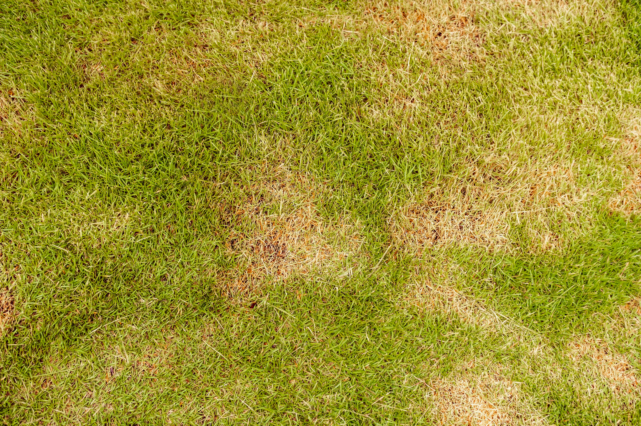
How to Prevent Brown Spots on Your Lawn
Because Dull & Dry Just Doesn’t Cut It
In 2002, United Parcel Service (UPS) ran an advertising campaign that asked Americans one question: “What can brown do for you?” The campaign was a huge success and brought life to a color that’s normally perceived as dull and boring.
If UPS asked your lawn the same question, the answer would be: “Nothing good.” Brown spots make our lawns look unhealthy, unkempt and unappealing. If your lawn has brown spots, the first step is understanding the cause. While your lawn can brown during a drought due to inadequate water, this isn’t always the cause. We’re going to cover some reasons why your lawn might have brown spots and how you can fix them. You might be able to treat the problem yourself. Or, it might be better to leverage the services of an NJ landscape company that has the tools, resources and experience to quickly and successfully restore your lawn.
Tips for Maintaining a Lush, Green Lawn:
- Water your lawn early in the morning or later in the evening. If you water your lawn in the middle of the day, the water can evaporate under the scorching summer sun. Water your lawn when it’s a little cooler to ensure it’s getting the water it needs (1-2 inches each week during the summer).
- Aerate the soil. Healthy lawns are able to breathe properly. Aerating the soil is the process of puncturing holes in the ground so air, water and nutrients can reach the roots. The fall is the best time to aerate your lawn.
- Stop brown patch fungus before it can spread. Brown patch fungus, also known as brown patch disease, is exactly what it sounds like: brown patches scattered across your lawn. This is a fungus that thrives in high heat and humidity, which explains why it’s most common during the summer months. This fungus spreads easily and needs to be contained. You can try treating the areas with a lawn fungicide from a retail store, but these products are often ineffective. Your best bet is to consult a professional NJ lawn care company to properly treat the affected areas and advise how to prevent brown patch fungus in the future.
- Train your dog to urinate in the park or in a designated area. In other words, don’t let your dog urinate all over the lawn. The nitrogen in pet urine burns and kills the grass. To prevent brown patches, train your dog to urinate in a designated area that’s less visible. You can also take your dog to the park or another location away from your property—just not someone else’s property! If your dog or another dog does urinate on the lawn, grab a hose and water the area to dilute the nitrogen.
- Look for signs of pest infestations. Cut worms, sod webworms, chinch bugs and grubs are some of the most common pests that canwreak havoc on NJ lawns. If our lawn care experts determine the brown spots are due to a pest infestation, we’ll recommend the proper treatment.
- Have your soil tested. The pH range of soil should fall between 6-7. Not sure where your soil stands? You can have it tested through the Rutgers Soil Testing Lab to assess your soil’s fertility and understand if certain treatments/adjustments are necessary.
Go Green With Castle Point
You simply cannot beat the look of a healthy, green lawn. It makes your home look more serene, welcoming and picturesque. If your lawn has been plagued with brown spots that aren’t going away, give us a call. We offer the full range of NJ lawn care services, including fertilization, disease management, renovation & restoration, aeration and seeding.
To go green with your lawn, contact us online or call Castle Point Landscape Design at 908.512.2267 today.